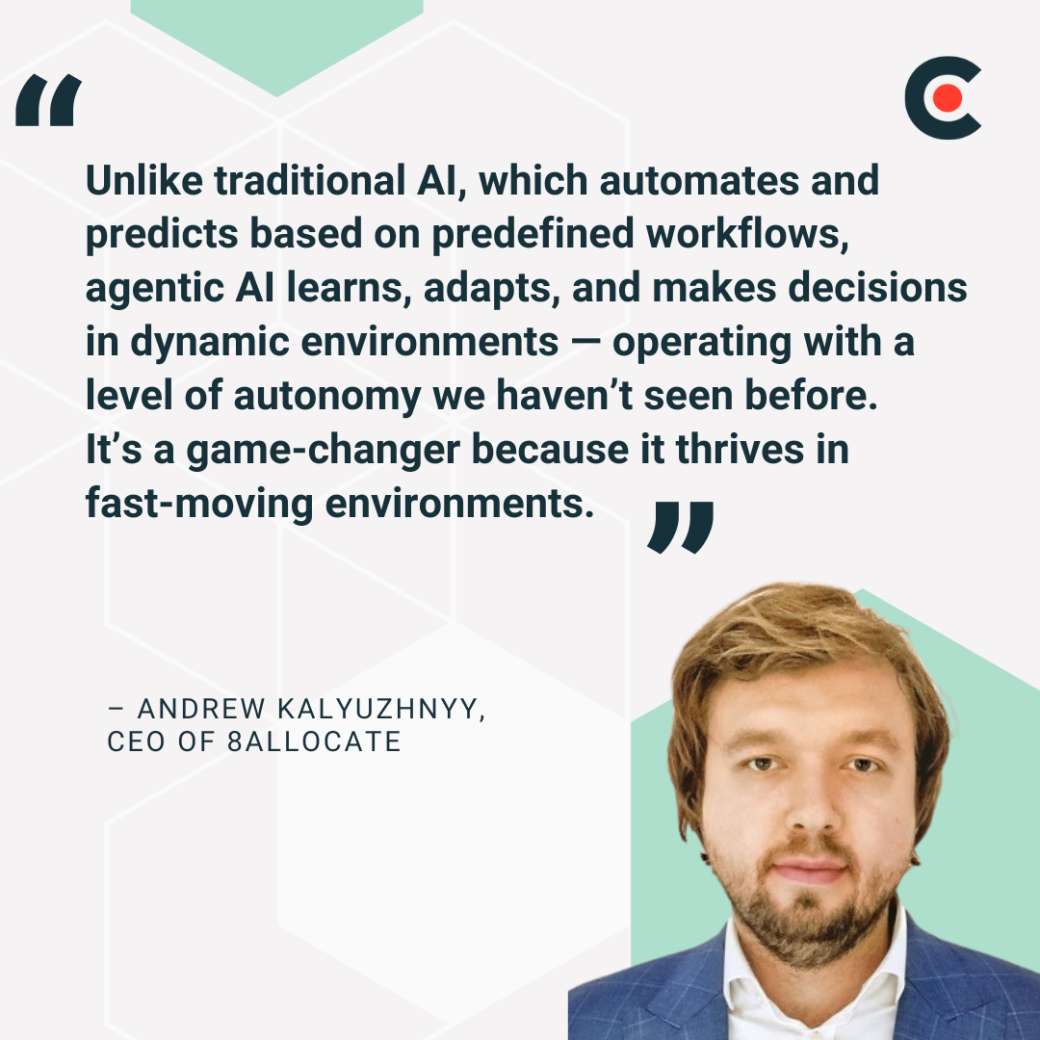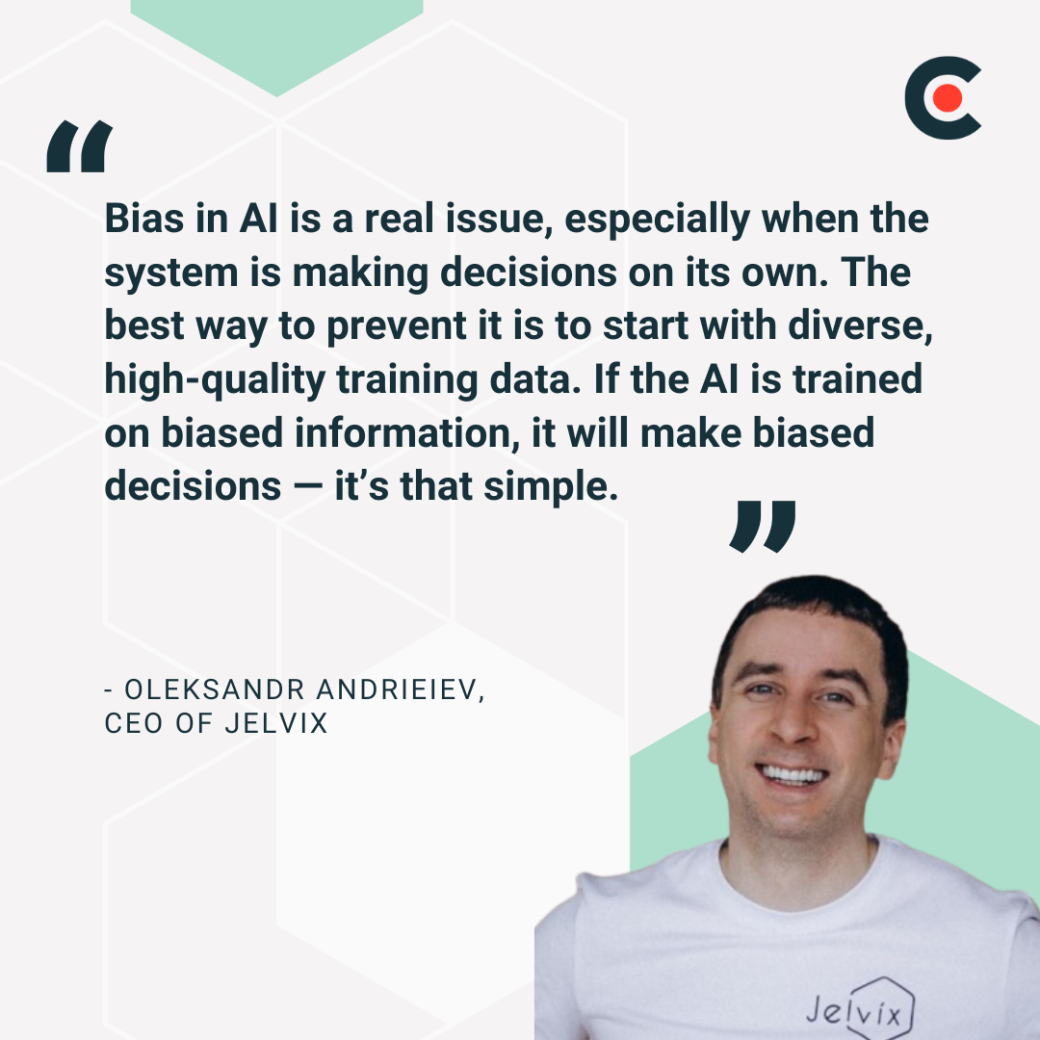

Updated June 27, 2025
Business competition has never been fiercer. Across industries, businesses are under pressure to operate faster and more intelligently — and to scale on the fly. That’s where agentic AI can give your business a leg up.
Unlike traditional AI, which follows pre-programmed rules, agentic AI learns from experience, adapts in real time, and can execute complex tasks autonomously. For businesses, this means greater efficiency, lower operational costs, and the ability to respond dynamically to market changes — without constant human oversight.
AI agents are already transforming various industries. In finance, AI agents analyze markets and adjust strategies in real time. Meanwhile, AI agents are used to predict demand fluctuations and optimize inventory in retail and supply chain management industries. They can personalize customer service interactions and anticipate customer needs before they arise.
Looking for a Artificial Intelligence agency?
Compare our list of top Artificial Intelligence companies near you
This level of automation allows your company to delegate complex decision-making to AI and frees human teams to focus on more nuanced functions, like strategy and innovation.
The bottom line? Companies that integrate agentic AI into their workflows aren’t just keeping up with the competition — they’re outpacing it. In this article, we’ll break down how these systems work, where they’re making the most significant impact, and what you need to consider when bringing AI agents into your business operations.
Agentic AI refers to artificial intelligence systems that operate autonomously to make decisions and adapt to changing conditions without constant human oversight. Traditional AI automation follows predefined rules, whereas AI agents can assess real-time data, continuously refine their approach, execute tasks independently, and improve their future decision-making processes.
Organizations across various industries are integrating agentic AI into their operations in any number of ways to enhance efficiency and decrease manual workloads on human staff.
For example, an AI-powered customer service agent can handle customer inquiries, analyze customer sentiments, make choices on its own without waiting for human intervention, and escalate more complex cases. This kind of automation can simplify workflows and hasten responsiveness to shifting market conditions.
Although generative AI and agentic AI share underlying machine learning principles, their functions inherently differ. Generative AI focuses on creating content—writing text, generating images, or producing code — based on patterns it perceives within its training data. It responds to prompts but doesn’t act independently.
Agentic AI, on the other hand, operates autonomously. It assesses situations, makes decisions, and adapts its behavior in response to real-time data. Instead of passively generating outputs, it actively engages with its environment.
“Unlike traditional AI, which automates and predicts based on predefined workflows, agentic AI learns, adapts, and makes decisions in dynamic environments — operating with a level of autonomy we haven’t seen before,” says Andrew Kalyuzhnyy, CEO of 8allocate. “It’s a game-changer because it thrives in fast-moving environments.”

This is a critical distinction for business. Generative AI has its place; it can assist with content production and data analysis, among other things. However, agentic AI can take action — managing logistics, fine-tuning marketing campaigns, or adjusting pricing strategies on the go.
In recent years, more and more companies have come to rely on AI to automate repetitive tasks, but agentic AI takes automation to the next level. AI agents do more than follow instructions like generative AI does. They analyze situations, adjust their strategies, and execute tasks without human oversight.
“Agentic AI is built for businesses that need automation, real-time adaptability, and scalable decision-making,” says Oleksandr Andrieiev, CEO of Jelvix. “Unlike traditional automation, which follows predefined rules, agentic AI adapts to new conditions in real time, making it an excellent fit for industries dealing with market volatility, dynamic pricing, or unpredictable demand.”
Integrating AI agents allows your business to react faster to changing conditions and lowers operational costs without constant human guidance. Business leaders are discovering that the integration of AI technologies can significantly enhance their overall efficiency and productivity. For example:
Overall, the adoption of agentic AI can lead to a significant competitive advantage for businesses, allowing them to operate more efficiently, make better decisions, and deliver superior customer experiences.
If you’re exploring AI agents, these five platforms stand out for their capabilities, flexibility, and ease of use. Each has its strengths and trade-offs, so choose based on your specific needs.
Summary: A powerful AI workflow automation tool designed to integrate with various services and streamline complex tasks.
Pros: No-code interface, strong API integrations, scalable automation.
Cons: Limited customization for advanced users, pricing can add up for high usage.
Summary: An open-source workflow automation platform that enables AI agents to connect across different applications.
Pros: Self-hosting option, extensive integrations, high flexibility.
Cons: Steeper learning curve, requires setup and maintenance.
Summary: AI-powered assistant designed for businesses to automate repetitive tasks and workflows.
Pros: Simple setup, great for customer support and task automation, user-friendly.
Cons: Limited advanced AI customization, fewer integrations than competitors.
Summary: A framework for building AI agents that can autonomously collaborate on complex tasks.
Pros: Open-source, highly flexible for developers, supports multi-agent interactions.
Cons: Requires coding knowledge, less plug-and-play than others.
Summary: A developer-friendly framework for creating AI-powered workflows using multiple agents.
Pros: Modular design, great for AI-driven automation, strong developer community.
Cons: Primarily for technical users, limited UI for non-coders.
Agentic AI’s applications already span many sectors, but some of the most impactful use cases include:
Software development, historically a time-intensive process, has become significantly more efficient with AI-driven automation. AI agents are already enhancing many aspects of the development lifecycle, such as:
GitHub Copilot, one of the most widely used AI-powered coding assistants, suggests entire code blocks, detects potential bugs, and automates repetitive coding tasks. AI-assisted coding reduces manual effort so development teams can focus on complex problem-solving rather than routine syntax.
Agentic AI is also improving software testing. AI-powered testing platforms, like Test.ai or Functionize, can perform various tasks autonomously, such as:
This substantially reduces testing time and decreases the likelihood of undetected bugs reaching production.
Cybersecurity is another area where AI agents can play a key role. AI-driven security tools, like those developed by Darktrace, continuously monitor applications for vulnerabilities. Detecting and neutralizing potential cyber threats before they escalate protects both internal systems and end users.
In 2024, more than 60% of marketers reported using AI to support their traditional activities, signaling a significant shift towards technology-driven marketing. As AI evolves, marketers are adapting their approaches, embracing AI agents for their ability to automate complex processes and deliver real-time insights.
“In marketing, companies are using AI to automate customer engagement, adjust campaigns based on real-time feedback, and optimize ad spend dynamically,” says Andrieiev. Ultimately, AI is reshaping how marketing campaigns are designed and executed, offering a competitive edge in an increasingly digital marketplace.
Many marketers are using AI agents to support:
For example, AI-powered recommendation engines, like those used by Amazon and Netflix, analyze past user interactions and behavioral patterns to suggest personalized content and products. These systems frequently improve their recommendations to increase conversion rates and customer satisfaction.
AI has already revolutionized digital advertising. Platforms like Google Ads and Meta use AI agents to analyze user behavior, predict which ads will perform best, and dynamically allocate ad spend for maximum ROI. Assessing real-time engagement enables AI agents to shift budgets between campaigns and channels so every dollar is spent effectively.
Another AI-propelled application in marketing is streamlining content creation. Tools like Jasper and Persado generate ad copy, social media posts, and email marketing campaigns based on data-informed insights. Targeted messaging for different audience segments can result in higher engagement rates with less manual effort.
Learn more about AI agents in 'How Marketers Are Using AI Agents.'
The finance sector benefits greatly from agentic AI systems, which can:
AI agents are much more advanced than conventional trading algorithms that rely on static models. They can assess live financial data, detect anomalies, and execute trades based on complex, evolving patterns.
For example, hedge funds increasingly rely on AI-powered trading systems that learn from ongoing market fluctuations. Firms like Bridgewater Associates use AI models to detect patterns and react within milliseconds to adjust portfolios dynamically.
Beyond high-frequency trading, AI agents are also helpful when deployed in asset management and financial advisory roles. Robo-advisors powered by agentic AI, such as those offered by Wealthfront and Betterment, provide clients with fully automated portfolio management. By assessing risk tolerance, monitoring market trends, and rebalancing investments as needed, these systems eliminate the need for human intervention while maximizing long-term gains.
Fraud detection has also improved exponentially with AI-driven monitoring tools. Banks use AI to analyze millions of daily transactions and instantly flag unusual behavior. JPMorgan Chase employs AI-powered systems that detect inconsistencies in transaction patterns and alert investigators to potential fraud before serious damage occurs.
Similarly, AI-driven compliance tools help financial institutions detect money laundering activities by identifying suspicious transaction networks more efficiently than human auditors ever could.
As part of a supply chain management system, AI agents can predict demand shifts, adjust inventory automatically, and hone logistics to curtail delays and lower costs. Companies with complex supply chains can rely on agentic AI to process real-time data from multiple sources — customer orders, supplier updates, and shipping routes — and keep operations running smoothly.
Retail giants like Walmart and Amazon use AI-powered inventory management systems that predict purchasing patterns and automatically replenish stock at optimal levels. Walmart utilizes an AI-fueled demand forecasting tool that frequently adjusts inventory across its thousands of stores. This way, Walmart reduces waste while keeping high-demand products available.
Beyond inventory management, AI agents are transforming warehouse operations. Companies like Ocado, a UK-based online grocer, have deployed fully autonomous fulfillment centers. The grocery chain’s On Grid Robotic Pick (OGRP) AI system directs thousands of robots to pick, pack, and ship groceries with remarkable speed and accuracy. The entire system regularly refines itself to learn from order patterns and revise the robots’ movements for better efficiency.
Logistics companies also benefit from AI-driven route optimization. UPS's On-Road Integrated Optimization and Navigation (ORION) system processes traffic data, delivery windows, and package volume in real time. This allows the AI to adjust routes dynamically, reduce delays, and minimize fuel consumption. With its AI-driven approach, UPS has saved millions of miles annually, cutting costs while improving service reliability.
As AI systems take on more decision-making responsibilities, the risk of bias becomes a growing concern. AI agents process vast amounts of data, but if that data contains biases — whether from historical inequalities, incomplete datasets, or flawed training processes — the AI will replicate and amplify those biases in its decisions.
“Bias in AI is a real issue, especially when the system is making decisions on its own,” says Andrieiev. “The best way to prevent it is to start with diverse, high-quality training data. If the AI is trained on biased information, it will make biased decisions — it’s that simple.”

Businesses using agentic AI must take a proactive approach to bias mitigation. That starts with curating balanced, representative datasets and continuously auditing AI outputs for unintended patterns. Your company should have clear protocols for monitoring AI decision-making and be ready to intervene when biased outcomes emerge.
Diversity is also essential within AI development teams. When engineers and data scientists from different backgrounds contribute to model training and evaluation, they are more likely to identify potential biases before deploying the AI. In this way, human oversight is still necessary, even as AI agents become more autonomous.
By recognizing the risks and taking preventative measures, your company can deploy more accurate and fair AI systems that align with ethical standards.
Using agentic AI is a fundamental shift in how businesses automate, adapt, and make decisions. While generative AI introduced new ways to create content and analyze data, agentic AI takes things further by acting autonomously in dynamic environments.
Across many industries, AI agents are already improving efficiency, reducing costs, and helping businesses stay ahead in unpredictable markets. If your company adopts agentic AI, implement it with proactivity and intention. That means addressing bias, maintaining human oversight, and integrating AI in ways that complement human expertise rather than replace it. Thoughtful and successful adoption will give your company a competitive edge.
AI agents are transforming business today, and their influence will only expand in the years ahead. Embracing it now will better position your company to compete — and succeed — in the future.


